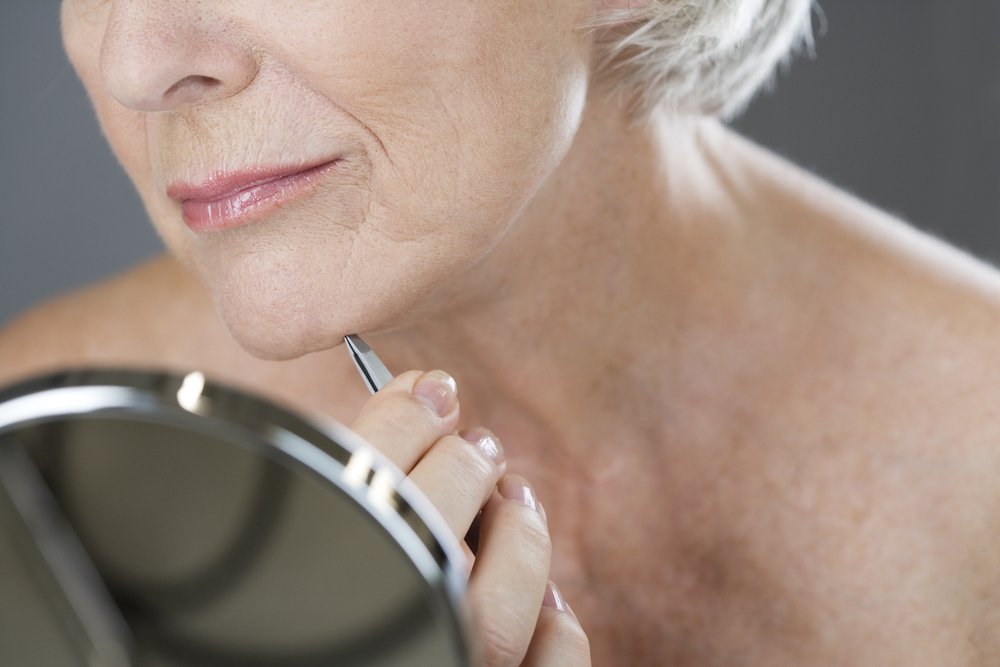There are many different methods to get rid of chin hair—each with its own set of pros and cons. Here’s what the experts have to say about the effectiveness of these various techniques.
I’m a woman — why do I have hair on my chin?!
If you’ve ever asked yourself that question, rest assured — you are not alone. Millions — yes, millions — of women struggle with unwanted chin hair. Some pluck, some wax, some shave (for real). Others book monthly med spa appointments and undergo expensive, painful treatments in hopes of solving the problem once and for all.
Even just one errant hair can drive an otherwise rational woman to distraction.
“Chin hair growth—or any facial hair—in women is caused by a combination of genetics and androgens or male hormones,” explains Donnica L. Moore, MD, President, Sapphire Women’s Health Group in Chester, NJ. “Anything that causes the balance between male and female hormones to change may cause unwanted chin hairs to sprout.”
The most common reason for this shift is approaching or reaching menopause. That said, “If facial hair growth affects pre-menopausal women and is accompanied by irregular periods, excess body hair, acne, and weight gain, it is time to see your gynecologist as it may signal a condition called polycystic ovary syndrome (PCOS),” says Dr. Moore. This affects 5-10% of young women, most commonly starting between ages 15 and 30.
When it is clearly a cosmetic issue (and a vexing one at that), there are many different methods to get rid of chin hair—each with its own set of pros and cons. Here’s what the experts have to say about the most commonly performed facial hair removal techniques.
| METHOD | DURATION | COST |
|---|---|---|
| Tweezing | 3-8 weeks. | Inexpensive. |
| Waxing | 3-8 weeks. | Inexpensive. |
| Shaving | 2-3 days. | Inexpensive. |
| At-Home Devices | Non-permanent, results vary. | Costs vary. The most popular light-based devices cost between $300 and $600. |
| Threading | 2-6 weeks at most. | Between 5-$10 per session. |
| Hair Removal Creams | Up to 8 weeks. | Approximately $50 per month. |
| Surgery | Permanent, but only performed in very specific instances. | Costs vary, depending on the plastic surgery procedure performed. |
| Laser Hair Removal | Three months and more. | Approximately six to eight sessions at $75 to $250 per session. |
| Electrolysis | Permanent, when performed by a skilled operator. | About $18 to $25 per 15-minute session, followed by maintenance. |
1. Tweezing
Tweezers can be taken out in a pinch to get rid of that stray errant hair that seems to appear out of nowhere, making this accessory a must-have for anyone with chin hair phobia.
However, it tends to be more of a trouble-shooting method as opposed to a way to permanently remove chin hair, and also takes quite a bit of manpower and manual dexterity.
As for the common belief that tweezing causes hairs to grow back thicker and darker — that’s a myth, plain and simple. “Tweezing is not likely to influence or cause diameter changes to hair texture,” says Elizabeth Cunnane Phillips, a trichologist at the Philip Kingsley Clinic in New York City. “Hormonal variables and genetic predisposition are much more likely to be at play.”
2. Waxing
Waxing has one pretty impressive benefit: instant gratification. “It rips out the hair at its root, but wax can be irritating — especially on the face,” says New York City dermatologist Michele S. Green, MD. “Some people may also develop ingrown hairs, which can become infected.”
3. Shaving
This is a relatively easy and cost-effective way to get rid of chin hairs that can be done discreetly in the shower, but risks include razor burn or folliculitis, Green says. Shaving can be a good option to get rid of stubble in-between laser hair removal sessions. “You can’t wax in-between laser sessions, as waxing pulls out the root and laser hair removal is only effective at the root.”
4. At-Home Devices
There are a host of at-home hair removal devices out there. Some use laser energy to get rid of unwanted hair, while others exfoliate away hair with a pseudo-razor device. Unfortunately, there are no head to head comparisons on how well these devices do or don’t work. “They may have a role for some people, assuming the cost is not prohibitive,” Green says.
5. Threading
Threading salons are popping up all over cities, and this hair removal method, which hails from Asia, does have some merit, Green says. “It works well especially on dark skin, and many of my patients find it much less irritating than other chin hair removal methods because it is less damaging to the skin’s surface.”
During threading, hairs are pulled from follicles as twisted cotton threads are rolled over them, plucking at the follicle level. Unlike tweezing, where single hairs are pulled out one at a time, threading remove short rows at a time.
6. Hair Removal Creams
Some depilatory creams and sprays are available over-the-counter, and then there is prescription Vaniqa. “They are both excellent ways to get rid of chin hair, but they are not permanent,” Green says. “When Vaniqa came out, it was all the rage and I wrote tons of prescriptions, but you have to use it all the time or the hair will grow back,” she says.
Store-bought depilatories can be irritating, but they don’t involve needles, zaps or yanking so they may be more palatable to some women. They can also be used in the privacy of your own home, as opposed to a storefront spa or salon.
7. Chin Surgery
“Sometimes if we are doing a lip lift or chin surgery, we can directly remove hairs from under the skin too,” says Jeffrey Spiegel, MD, Chief of Facial Plastic and Reconstructive Surgery and a professor at Boston University School of Medicine.
While this option is permanent, it obviously isn’t practical for women who only want to do away with their chin hairs.
8. Laser Chin Hair Removal
Laser hair removal is many an aesthetic doctor’s go-to for unwanted chin hair. “For years, electrolysis was the only game in town, but that was then,” says Green, who performs various cosmetic laser treatments at her busy Manhattan practice.
“It’s a very popular treatment for women’s chins, lips, and between eyebrows,” says New York City plastic surgeon David Shafer, MD. “Usually four to six treatments are required for long-term results.”
Laser hair removal works best for dark, coarse hairs, and when hair does grow back after a treatment, it tends to be finer and lighter in color. And while the initial cost may be a little steep for some, it makes sense in the long run.
“Over your lifetime, the cost is cheaper than any other method, and in some cases laser treatments can result permanent hair reduction,” says Michelle Henry, MD, a dermatologist and Mohs surgeon at Sadick Dermatology in Great Neck, NY.
9. Electrolysis
“While laser hair removal works best on dark, coarse hair, electrolysis may be a better if you have gray or light hair,” says Green. Furthermore, electrolysis is the only chin hair removal technique that can actually claim to be 100% permanent when performed by a well-trained professional.
During treatments, a thin probe is placed in the hair follicle to blunt hair growth via shortwave radio frequency. After a series of appointments the follicle is destroyed, and hair growth stops forever.
“It hurts more than laser hair removal and takes longer to see results, but for light and gray hairs, there is nothing else,” say Green.
Spiegel agrees: “If there are light hairs or ones that can’t be fixed otherwise, we recommend electrolysis.”









